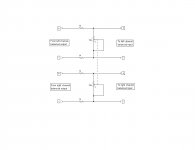Have a Ventus that currently uses single ended input with an individual volume control for each channel. (Old ears need more adjustments!) Am switching to Opus to drive it and am uncertain as to how to wire pots when using balanced input. Any help for the newby/old guy?
Pete
Pete
If you are feeding a balanced output into a balanced input, you can build a volume control using a dual (stereo) pot for each channel.
It's wired just like any other level control pot. The + preamp output goes through one section and the - preamp output goes through the other section.
Do the same for the other channel.
There are other methods if you can afford to lose some audio level between your preamp and your power amp.
It's wired just like any other level control pot. The + preamp output goes through one section and the - preamp output goes through the other section.
Do the same for the other channel.
There are other methods if you can afford to lose some audio level between your preamp and your power amp.
Frank; Thanks for the info--I wondered if the dual pot was necessary---also have some concern over the tracking error between pot halves and what effect it might have.
Brian; I will start out with Volumite and see what my "earspeakers" tell me. By the way, any idea when the SPDIF module will come available again? It and volumite are the last links in the chain for my headamp.
Pete
Brian; I will start out with Volumite and see what my "earspeakers" tell me. By the way, any idea when the SPDIF module will come available again? It and volumite are the last links in the chain for my headamp.
Pete
Using a dual pot on balanced input will totally destroy common mode rejection ratio.
Mike
No it will not.
The circuit remains balanced.
To retain high common mode rejection ratio the resistances must be matched to high precision, that's not going to happen with pots in there.
It's line level.
In the real world, the slight difference in resistance between the + and - legs of the attenuator will not be a problem.
In the real world, the slight difference in resistance between the + and - legs of the attenuator will not be a problem.
Frank, thinking furter on the subject, using the schematic you posted would certainly compromize CMRR, which may not be important in a home where cables are likely to be rather limited in length, but more importantly, you would be compromizing the other advantage that balanced has over single ended, which is that signals are not ground referanced, so possibility for introducing ground loop issues is increased. (by the way, you left the ground connection out of the schematic). Another disadvantage in my opinion is it would require using two dual pots to control both channels. I think a better way would be to use something like this:

Mike

Mike
Gentlemen; it would appear that this process involves a degree of uncertainty and I will experiment with both ideas. Initially however, I'll go with Volumite and judge whether or not to venture further. There is the possibility of single line level output pots from Ventus although that also has some drawbacks. Thank you for your input.
Brian look forward to getting the SPDIF module as it comes available.
Pete
Brian look forward to getting the SPDIF module as it comes available.
Pete
Frank, thinking furter on the subject, using the schematic you posted would certainly compromize CMRR, which may not be important in a home where cables are likely to be rather limited in length, but more importantly, you would be compromizing the other advantage that balanced has over single ended, which is that signals are not ground referanced, so possibility for introducing ground loop issues is increased. (by the way, you left the ground connection out of the schematic). Another disadvantage in my opinion is it would require using two dual pots to control both channels. I think a better way would be to use something like this:
View attachment 241560
Mike
A ground reference is not necessary on my circuit. When the pots are at maximum attenuation, the + and - (tip and ring) are connected together.
I've used your circuit and it works very well. The only problem is that the circuit provides signal attenuation ... even when the controls are at maximum resistance.
But you are correct. The circuit does compromise the CMRR. As you said, not a big problem with short cable runs. Not a big problem when using good quality shielded cables either.
If you do decide to use an analog volume control, you could just use a Joshua Tree, which would have fewer tracking issues compared to a multi-gang pot.
Brian; Space/ cost are deal breakers for JT. Have ordered Volumite and chip and we'll see what happens after build is complete. Will be looking for SPDIF module as soon as it comes available.
Pete
Pete
- Status
- Not open for further replies.
- Home
- More Vendors...
- Twisted Pear
- Volume control for balanced inputs
